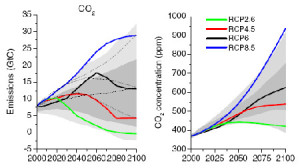Bunch of little things to mention, so one big post.
First, here’s an excellent TED talk by Gavin Schmidt. He’s a climate scientist at Columbia University’s Earth Institute and is Deputy Chief at the NASA Goddard Institute for Space Studies. He’s also a really great guy. But the talk is excellent and only about 12 minutes long. He explains how they know the climate models work and what the climate models predict until 2099. It’s quite interesting.
OK, it appears I can’t embed TED videos. Here’s the link. PLEASE give it a view.
Along the lines of those models, I asked and Gavin said that this article contains the information for those final three models. The upper model is RCP4.5, and below RCP2.6 and RCP8.5
Here’s the data of the mix of energy sources indicated for those models (from the Guardian article).

The 8.5 (business as usual model) is the dark blue line. Emissions increase at a steady rate and the global CO2 concentration finally goes past double what it is now. The other models have a very steady reduction in global CO2 emissions and thus the atmospheric levels increase more slowly and (in the lowest emission scenario) finally being to creep down.
But one thing of note. Even in the most optomistic scenario, the atmospheric CO2 concentrations still top out above what they are now and it will take the remainder of the century to reduce back down to levels that are still above present levels. And that the most aggressive strategy… which doesn’t look likely.
However, there is some hope. This is an interesting article about battery technology and economics. This reminds me somewhat of The New Deal and the public works projects of the time. To get out of the recession, the government hired people to build the national highway system and other infrastructure type projects.
Now, those kinds of jobs and projects will be more high tech. Tesla is planning on the largest battery factory in the world. If Tesla builds this factory, they will produce enough battery packs for half a million Tesla vehicles each year. Which is more than they have produced in the entire companies history so far.
But with scale comes economy. Estimates are that a Tesla’s pricetag is almost 70% battery. If that price comes down, then battery cars become cheaper. I’d buy one now, but I can’t afford $70k. Anyway, this creates jobs in the US and helps the environment.
About a week ago I read some articles on a old battery tech that’s been ‘rediscovered’ and researchers are using new technology to optimize them. Of course, I can’t find the article now because I can’t remember what the batteries were called.
This could really help out with the renewable naysayers too. This article about a small island, that in less than month will be using 100% renewable energy. They have sufficient wind capacity to run everything on the island AND pump water to the top of a mountain. When the wind’s not blowing, water flows downhill running turbines that produce electricity.
That single island (population 10,000ish) will cut carbon emissions by 20,000 tons per year. But more importantly, it shows that it is possible for entire communities to be completely run on wind power with storage system. Yes, it’s only 10,000 people. But then, the Wright brothers started off with a single person flyer too.
One note, that chart above that shows the amount of carbon dioxide emissions is labeled in gigatons. Sadly, that single island represents 0.00002 of a Gigaton of carbon dioxide emissions. But it’s a start and other off-grid islands are following suit. Plus, it’s saving them a ton of money in oil purchases and generator upkeep.
P.S. I’m still working on the rest of chapter 11. It’s a hard slog. I’m reading dozens of papers (probably more than Meyer actually read for understanding).
EDIT: Another one just came in the latest Science. Perovskite solar panels are made from cheap, easy to manufacture materials. And this report has them hitting several new records in efficiency. New research has these cells at a 20% efficiency rate. If these were paired with modern solar panels in commercial production, the total efficiency could approach 32%. That is, 32% of the light hitting the panels would be transformed into electrical energy.
A few minor problems. These materials breakdown rapidly in the presences of water and they only last a few hundred hours. But amazing strides have been in five years when the top efficiency was around 3%.
